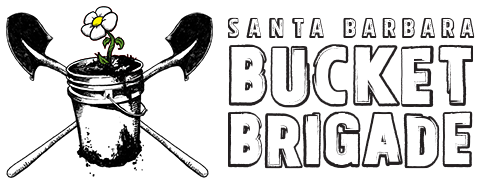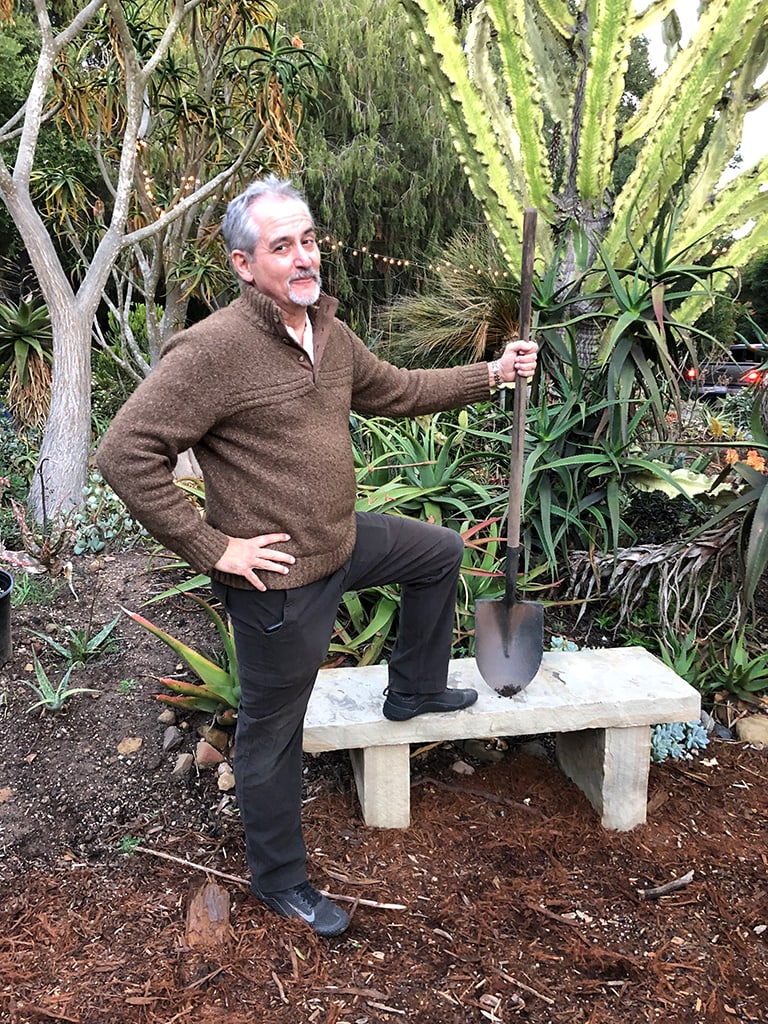Having been part of the Tea Fire recovery community, my email was included in Abe’s first call for help after the debris flow. I noted the details, put a shovel, mask, and gloves in my car, and headed over that first weekend. Things were chaotic all around Montecito, but the check-in table was an oasis of calm, though it was clear that things were being worked out on the fly. I got my group armband of red tape and was directed to the targeted properties.
There were little groups of people laboring in almost every yard. Some places were more messed up than others. Many of the tasks seemed overwhelming. So I looked for something doable. Two volunteers were starting to clear a walkway. The house hadn’t been flooded, but there was a lot of mud between the street and the front door. Making it possible for the homeowners to get in and out without getting muddy looked like an achievable task, and I stepped in. It was difficult to determine the path of the buried walkway. I challenged my fellow volunteers to see if we could reach a little landmark — a walkway light sticking out of the mud about four feet away — in 15 minutes. The pace quickened, and we beat our goal. This became our tool for the rest of the day: Pick a bite-sized task, set a time goal, and get after it. Then we’d take a short break before diving in again. Each time, we seemed to gain momentum, and the spirit of accomplishment gave us energy in spite of the physical effort.
Each little zone of volunteers seemed to self-govern, with groups making casual introductions and working together. Some would wander between projects. More organized groups worked in conjunction with heavy machinery. By lunch, I had been at four different homes, and each was showing signs of improvement.
People’s faces carried grim optimism. The air was not light. Humor was of the gallows variety.
Once while working on clearing a porch and walkway as a machine cleared the driveway, the woman of the house came to the front door and shrieked her approval. The whole area perked right up.
After clearly several walkways, I wandered up the street to where a car was parked just off a driveway that had been cleared by a skid loader. I asked if the car started. Someone went in the house — where the owner was attempting to recover items from the muck — and returned with the keys. It started, but the wheels spun — the car had been floated by the mud surging underneath it. There were four of us, and we started clearing mud from in front of the wheels, which resulted in the car settling some. When we had cleared the front of the chassis, we tried driving it off the mud again. The owner came out and shook her head: “There’s no point in doing this. I don’t have my driver’s license. It’s lost in the mud.”
Over the next ten minutes she made one self-defeating statement after another. I realized that it was the affected people who needed the most attention. If we only we had had as many skilled counselors as we had shovels. While relieved to be alive, or that their house was still standing, or happy to express their gratitude, they were all in shock, overwhelmed by the circumstances. Even those who had suffered little direct damage were distressed by the loss of life and damage to their community. The aftermath was psychologically and emotionally intense.
The real strength of the volunteers was their indefatigable sympathy and optimism. Moving buckets of mud was just an action that kept their hands busy while their presence and hearts held the space of a better future for those whose lives had been upended. At one point, I suggested to the woman that she take a deep breath, and focus on that. When we got her car out of the mud and onto the street, she still expressed concern that she shouldn’t drive it without her license. I suggested that if she got pulled over, she would have the sympathy of any officer once she explained the circumstances. She remained doubtful.
That first day, we pulled out several cars, cleared a lot of walkways, and generally learned some processes to make our efforts more effective. The second weekend we learned that in spite of the exclusion zone — set up by law enforcement to keep looters away — someone had gotten into the neighborhood and stolen Bucket Brigade wheelbarrows and other equipment.
Forms and paperwork got refined, and a leadership structure emerged. A daily ritual of briefing, debriefing, and pep talks was established. There was food made by other volunteers. My favorite was a tray of wraps, each with a personal note from the teenagers who had prepared them. By the second month, things felt stable and organized, almost regimented. The parking lot at Manning Park would fill with volunteers. Vans would shuttle them to locations. Soon enough, there were new projects, like clearing mud from around oak trees. There were days when there were just as many people with cameras documenting what we were doing, or at least it seemed that way. That turned out to be the day Jack Johnson would drop by to help.
One hopes that such occasions will be rare, and that a how-to guide will be published by the original Bucket Brigade leaders, because we know that things like this happen anywhere and consistently enough — but responses like the Bucket Brigade are few, despite the good will and nature of most people.

